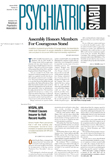About 1.1 million Americans received treatment for addiction to drugs, alcohol, or both on a typical day last year, according to findings from the 2002 National Survey of Substance Abuse Treatment Services (N-SSATS). Half of those receiving treatment were addicted to both drugs and alcohol.
A minority, 21 percent, were in treatment for alcohol abuse alone, and 31 percent were in treatment for drug abuse alone.
The largest proportion of those in treatment—48 percent—were being treated for addiction to drugs and alcohol. About 8 percent of the 1.13 million addiction patients were under age 18 last year.
Researchers with the Substance Abuse and Mental Health Services Administration (SAMHSA) conduct the survey annually to collect data on the characteristics of alcohol and drug treatment facilities across the United States. The survey results assist SAMHSA and state and local governments in evaluating the extent to which drug and alcohol treatment services are provided and forecasting the need for additional resources. SAMHSA also uses the results to update its databases containing information about treatment facilities in the United States.
A total of 13,720 treatment facilities, 96 percent of all eligible facilities, participated in the survey. Those not eligible included jails and prisons offering treatment services and facilities that did not collect data on treatment services.
The following are some of the characteristics of the treatment facilities for which data were available:
• Overall, 60 percent of facilities considered treatment for substance abuse problems (including alcohol abuse) their main focus, and a little more than 25 percent of the facilities considered both substance abuse and other mental health treatment services to be their focus. Approximately 8 percent of treatment facilities reported that providing mental health services was a primary aim, while 3 percent focused primarily on general health care.
• Seventy-four percent of facilities offered standard outpatient services, and 44 percent offered intensive outpatient services. A quarter of the facilities offered residential services, but just 4 percent of them offered treatment through inpatient services.
• Nearly half of the surveyed facilities offered treatment for people with mental illness and a substance use disorder.
• Thirty-seven percent of facilities offered programs or groups for adolescents, and 14 percent offered specialized services for people aged 65 and older.
• Of the 13,720 treatment facilities, 1,080 dispensed methadone or levo-alpha acetyl methadol as part of an opioid-treatment program.
In an October press release, SAMHSA Administrator Charles Curie said, “At SAMHSA, building treatment capacity is a high priority. We are hopeful that the president’s Access to Recovery program will be funded to allow an additional 100,000 people to enter treatment and rebuild their lives.”
In his January state of the union address, President Bush announced a three-year, $600 million federal treatment initiative, which would provide approximately $200 million in vouchers each year to support treatment for people with drug and alcohol problems.
As part of the initiative, state governors would compete for the funds, according to SAMHSA officials, which would be used to supplement existing treatment programs.
At press time, Congress had not yet approved a dollar amount for Fiscal 2004 appropriations to the Department of Health and Human Services, which is where funds for the Access to Recovery will be included.
Additional findings from the National Survey of Substance Abuse Treatment Services are posted on the Web at www.samhsa.gov/oas/dasis.htm#nssats2. More information about Access to Recovery is posted at www.whitehouse.gov. ▪
